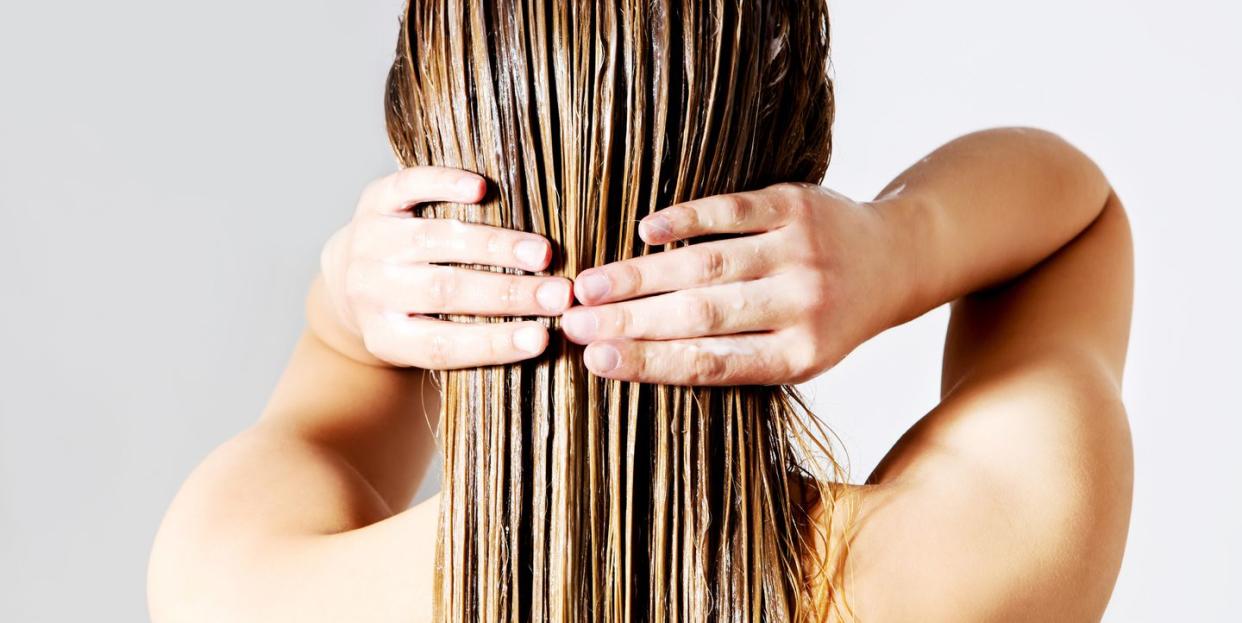Exfoliating Your Scalp May Be the Secret to Healthier, Shinier Hair

There are some basics of hair care that pretty much everyone follows-namely, that you should be shampooing and conditioning regularly. But things like dandruff, irritation, thinning hair, and excess oil can crop up, and that’s when your standard shower routine isn’t going to cut it.
That’s where scalp exfoliation comes in. Think about it: When you exfoliate your face, your skin looks and feels cleaner, smoother, and healthier. Exfoliating benefits your scalp in a similar way and helps keep your hair in tip-top shape.
“Dirt, oil, dead cells, and debris from hair care products buildup on the scalp and may lead to irritation and inflammation,” says Joshua Zeichner, MD, director of cosmetic and clinical research in dermatology at Mount Sinai Hospital in New York City. “Periodically using a gentle exfoliating product can remove this buildup.”
Here’s everything you need to know about scalp exfoliation, plus the best way to do it.
Why is scalp exfoliation so important?
Like the skin on your face, your scalp is packed with sebaceous glands, which produce an oily substance called sebum, per the U.S. National Library of Medicine. That sebum actually helps to keep your hair soft, shiny, and healthy-looking.
But when it gets out of control, your sebaceous glands become clogged, which can cause a buildup on your scalp and lead to dandruff, itching, inflammation, and dry hair, says Gary Goldenberg, MD, assistant clinical professor of dermatology at the Icahn School of Medicine at Mount Sinai Hospital. “This can cause hair breakage and fragility. If the inflammation is deep in the scalp, it can also cause hair loss,” he says.
Consistently using hair styling products, like dry shampoo, hair spray, and mousse at your roots can also clog hair follicles and make your hair look lifeless-especially if you prefer to skip washes and freshen up with products in between.
The goal with scalp exfoliation is to remove dead skin cells and gunk to open up your sebaceous glands, so that oil can flow freely without blockages, Dr. Goldenberg says.
How to exfoliate your scalp the right way
It’s important to note that scalp exfoliation isn’t for everyone. If you’re struggling with itching that won’t quit, hair breakage or hair loss, or you have a condition like psoriasis or eczema, you really should see a dermatologist before trying this at home to ensure you don’t cause further damage to the skin, Dr. Goldenberg says.
Similarly, if you have dandruff “it’s important to get to the root of the issue rather than simply exfoliating,” Dr. Zeichner says, since dandruff at its core is caused by an overproduction of yeast that you can’t simply buff away.
But if you and your scalp are otherwise healthy, there are a few ways you can go about scalp exfoliation.
Use a flake-fighting shampoo
Dandruff shampoos contain active ingredients that fight yeast buildup, reduce inflammation, and gently exfoliate. Look for salicylic acid, coal tar, pyrithione zinc, and ketoconazole on the label. Neutrogena T/SAL as well as Nizoral A-D Anti-Dandruff Shampoo are both great options.
To use them, lather up and let them sit for a while. “It’s important that any of these shampoos are in contact with your scalp for three to five minutes,” Dr. Goldenberg says. He recommends using standard shampoo and conditioner afterward, since medicated shampoos don’t really nourish your hair.
If you don’t struggle with dandruff, but want something that gently buffs away product buildup, you can also look for a shampoo that contains fine physical exfoliators, like charcoal powder or sea salt.
Try a scalp scrub
Using a scalp scrub before your typical shampoo and conditioner can also be helpful, Dr. Goldenberg says, although he recommends running the ingredients by your dermatologist before using a particular product. “While some may be good exfoliators, they may be damaging to hair itself,” he says. When in doubt, go for exfoliating products that also include moisturizing ingredients.
A note on using brushes for exfoliation
Some people swear by using a teasing brush to loosen up debris and buildup before washing, but Dr. Goldenberg recommends being cautious with this one. “While it may help the scalp, it may also damage your hair,” he says. So, if you do decide to use a brush, be gentle with it.
As for how often you should exfoliate your scalp, Dr. Goldenberg recommends using a special shampoo three times a week if you’re really struggling with build-up, but pay attention to how your scalp and hair reacts. If you prefer to use a scrub, cut back to once a week if you feel like it may be too much.
If you’re still dealing with flaking or your scalp just doesn’t seem right after all that, he recommends talking to a dermatologist to make sure you don’t have an underlying skin condition.
Stay updated on the latest science-backed health, fitness, and nutrition news by signing up for the Prevention.com newsletter here. For added fun, follow us on Instagram.
('You Might Also Like',)

